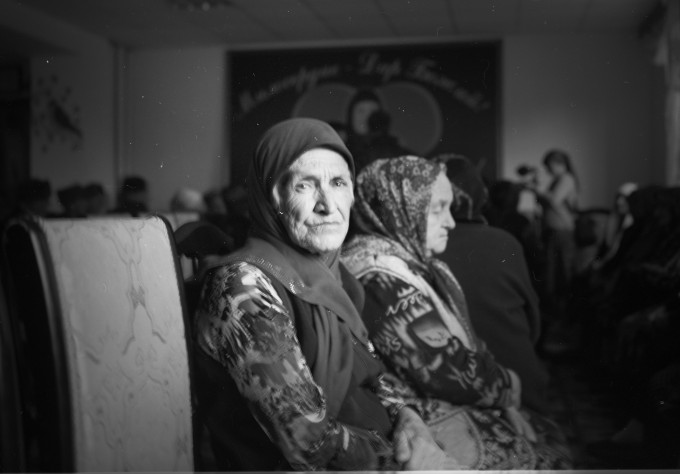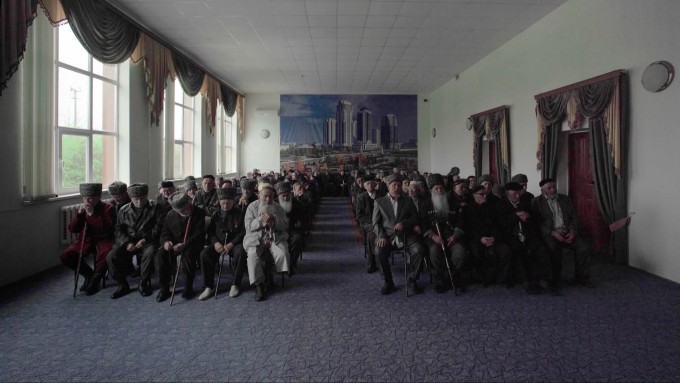
On a double-sided postcard that someone handed me in Grozny, the capital city of the Chechen Republic, a young, armed soldier gazes with pride into the distance. The boldly-colored image—in a design ubiquitous in a past, yet not so distant epoch–is complemented by the slogan: 23 Fievralia, Den’ zashchitnika Otechestva [23rd of February, Defender of the Fatherland Day; former Red Army Day]. Yet, when you turn the postcard over, there appears another, very different image: from behind a wooden fence, greyish faces look out at us sorrowfully, fearfully. The same date, the 23rd of February, is also referred to as the date of the deportation of the Chechen and Ingush nations.
It was on this day in 1944 that Lavrentiy Beria executed Stalin’s plan: mass expulsion of the Chechen and Ingush peoples accused of collaboration with the Nazi troops, regardless of whether they were children, women, old men, and even those who were dead. It is estimated that during the 13 years of exile, half the Chechen population perished, those who escaped the mass killings falling victim to exhaustion, illness and famine. It was only in 1957, four years after Stalin’s death, that those who had survived were allowed to return from the remote regions of Kazakhstan and Kirgizstan, and even then only to Chechnya.
In the winter and spring of 2016, Aslan Gaisumov traveled throughout Chechnya in order to meet the witnesses of those traumatic events. He spoke with almost 300 people who, like his own grandmothers, had been exiled during the Second World War. Of these, 119 agreed to meet in Grozny, the youngest was just one month old when deported.
Aslan Gaisumov himself was born in Grozny—where he still lives and works—in 1991, a few years before the First Chechen War started. As did most of his peers, he grew up in the refugee camps. He says that to understand the last war, one needs to acknowledge the previous one. It is, however, not only a firm belief in his own responsibility as an artist to mediate the past, but also an urge to rediscover his personal story through the experiences of others that has become a driving force for his poignant works.

People of No Consequence is a video by Aslan Gaisumov that depicts the first encounter of the Chechens who had survived the deportation, taking place almost 60 years after their repatriation. We see them entering, one by one, the empty hall of a public institution, seating themselves row by row, in the traditional manner of their communities: men first, women behind. We note their occasional, tentative, friendly gestures. On the wall at the back of the room, a large poster with a panorama of Grozny depicts the city in its present shape, with all traces of recent wars erased and consequently replaced by a kind of hybrid, imaginary architecture.
The camera fixes the frame as its central point, thus forcing the viewer to watch the scene directly, without changing position. The video continues until the last chair is occupied, with no words expressed, no extra movements taken. The sound remains almost inaudible. The closing text rolls on: factual, dispassionate, it describes the historical circumstances of the meeting.
Aslan Gaisumov’s language is simple, unambiguous and direct. His humble approach to the history is far from any kind of sensationalism. The silence that formally defines his artistic vocabulary becomes a statement, a form of re-enactment of the disregarded history that, until now, has not found its own articulation. The power of Gaisumov’s artistic gesture lies in his crafting the circumstances for the artwork rather than in its transformative features, while the artwork itself functions here as a by-product, an echo of everything that has happened backstage.

Susan Sontag observes that “to designate the hell is not to tell us anything about how to extract people from that hell and how to moderate the hell’s flames.”1 Yet, even to simply acknowledge the existence of human suffering caused by other’s depravity is positive in itself as it disrupts superficiality, naïve innocence, and amnesia.
There is no doubt that today’s media support this process efficiently. With instant coverage of almost every act of terror, the images of war and violence are accessible globally. Their formal language is radical, provocative and compelling but it does not provide a critical space where the connection between different temporalities and modalities–the past and the present, the suppressed and dominant narratives–could be negotiated. If there is anything that art can do within the noise produced by contemporary streams of information, it is to subvert the language of representation and articulation of time and its relevant powers.
Gaisumov rejects the hyper-reality of the language of the media; instead of the gruesome images that we face each day to the point of complete anaesthesia, he confronts us with the impassive faces of the trauma survivors. Those silent images, accompanied by the calm, factual narrative of historical events, convey the impossibility of coming to terms with and expressing the pain endured. “This is not a silence, actually, ” Gaisumov says. “It is a form of renouncing speech, very powerful. And they are waiting for someone to give them answers. Because why that they are the ones who should do the talking? For most of them, I was the very first person who has ever recalled that time. After so many years. Can you imagine…”
In the quiet gathering of survivors, more than half a century after the dramatic events, the discrepancy between history and memory has manifested itself. The Chechen history is still largely ousted from official historical accounts: but history, as written by the victors, is a single narrative with little regard for those who perished. Gaisumov seems to be desperately trying to embody the history in the momentarily captured faces of survivors before their stories disappear irretrievably.
About the author
Anna Smolak is a curator based in Krakow, Poland. She studied history of art at Jagiellonian University in Krakow and cultural diplomacy at Collegium Civitas in Warsaw. Her interests are based in contemporary institutional critique and the examination of alternative modes of collaboration and organization. She has investigated the notion of locality, periphery, and exclusion, focusing particularly on east European and post-Soviet contexts, while contributing with exhibitions and projects to numerous institutions in Poland and abroad.
Notes
- Susan Sontag, Regarding the Pain of Others (New York: Picador/Farrar, Straus and Giroux, 2003), . 89. ↩



